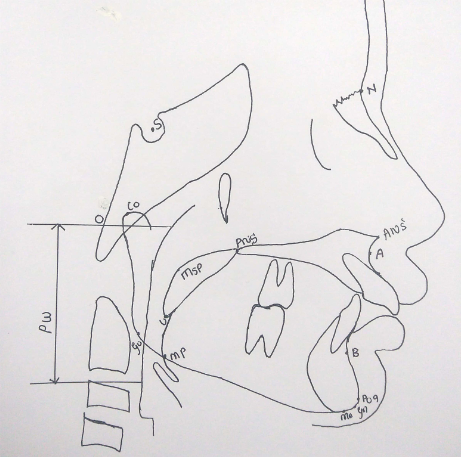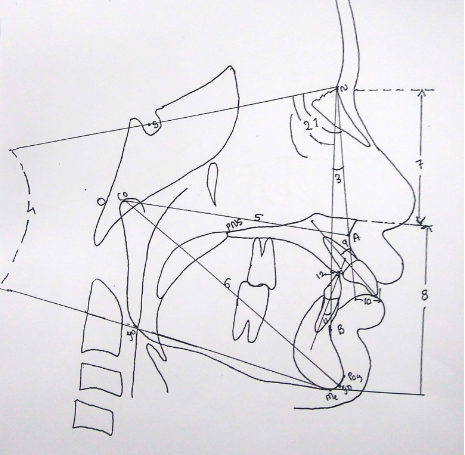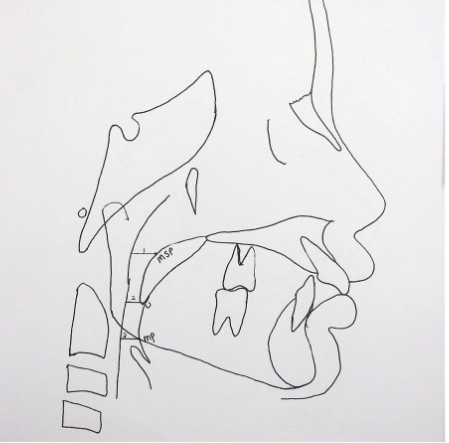Introduction
Upper airway structures play an important role in the development of the craniofacial complex.1, 2 Deficient breathing may occur as results of narrowing of pharyngeal airway dimensions; this may leads to reduction of growth hormone levels in growing children and obstructive sleep apnoea in adults.3, 4
Preservation of skeletal phenotype even after growth in case of skeletal class II malocclusion is evident. It is important to render effective orthodontic treatment during the growth period, which not only improves dental, jaw function and dentofacial esthetics, but also preventing the possible OSAHS and snoring.5
A number of mandibular advancement oral appliance such as removable and fixed functional appliances clinched popularity in recent years to achieve better overall mandibular growth, growth in the appropriate direction and also prevent oro-pharyngeal collapse by modifying the posterior position of the tongue.6, 7
There are few studies have shown the potency of PowerScopeTM (Class II Corrector) in correction of skeletal class II malocclusion,8 whereas no studies on effect of PowerScopeTM on oropharyngeal airway dimensions. This prospective study as our knowledge, is first of its kind in the English literature evaluate the effect of PowerScopeTM (Class II Corrector) on skeletal, dental and oro-pharyngeal airway.
Materials and Methods
Twenty (M = 3, F = 17) growing subjects with age group of 11 to 14 years reporting to the department of orthodontics were selected based on skeletal class II malocclusion on account of restrusive mandible, horizontal growth pattern, full cusp class II Molar relationship, overjet of exceeding 6mm, pretreatment visual treatment objective positive. Patients with skeletal class II with prognathic maxilla, respiratory problems, obvious naso pharyngeal obstruction, and history of previous orthodontic treatment were excluded from the study. Written consent was obtained from the parents of the patients and ethical clearance was obtained from institutional ethical review committee.
20 patients in the cervical vertebral maturation index9 stages 4 and 5 were selected for study and randomly assigned to 10 experimental groups and 10 control group respectively.
Pre-adjusted edgewise appliance (0.022” MBT slot) followed by PowerScopeTM Class II corrector was used for experimental subjects. At the end of the aligning and leveling, (Figure 1) PowerScopeTM Class II corrector with the help of driver, engaged mesial to the first molar on the maxillary rectangular stainless steel arch wire and distal to the canine wire on to the mandibular rectangular stainless steel arch. In order to prevent the flaring of the lower anteriors, 100 labial root torque was given in lower wire. Patients underwent fixed functional therapy for a period of 6 months, Lateral cephalograms were obtained before and after 6 months of fixed functional phase.
Control group subjects were started with fixed appliance therapy only in upper arch, it would be unethical to withhold control group without treatment. Lateral cephalograms were obtained before and after 6 months of upper arch alignment and then patients were treated for skeletal class II malocclusion.
Cephalometric analysis
Lateral cephalograms were made under standardized conditions. The head of the patient was erect and exposed at the end of expiration phase of the respiration. Instructions were given to the patient not to move their head and tongue and not to swallow while taking cephalogram exposure. All cephalograms were recorded in the same machine with same exposure parameters using Kodak 8000 C digital x-ray machine and traced manually by single individuals to reduce systematic error of cephalometric measurements.
In this study 8 skeletal, 5dental and 3 pharyngeal measurements were measured to accesses skeletal, dental and oro pharyngeal airway in skeletal class II patients. (Figure 2, Figure 3, Figure 4)
Figure 2
Cephalometric landmarks used in the study. N: Nasion; S: Sella; Co: Condylion; ANS: Anterior Nasal Spine; PNS: Posterior Nasal Spine; A: Point A; B: Pog: Pogonion; Gn: Gnathion; Me: Menton; Go: Gonion; MSP Centre of soft palate at the junction of PNS-U line; U: Soft palate tip; MP: Juncture of lowermargin of mandibular body and posterior border of tongue; PW: Posterior pharyngeal wall

Figure 3
Skeletal and dental cephalometric reference planes,angular and linear measurements used in the study. Reference planes: SN: the line joining S and N; Mandibular plane: line joining Go and Me; 1. SNA: angle between SN and NA line; 2. SNB: angle between SN and NB line; 3. ANB: angle between NA and NB lines;4.SN-MP:angle between the SN plane and Mandibular plane 6. Co-A: effective midfacial length: linear distance between Co and A; 7. Co-Gn: effective mandibular length: linear distance from Co to Gn; 8. UFH: Upper facial height, distance from N to ANS; 9.LFH: lower facial height distance from ANS to Me. 9. U1-NAo: angle between the NA line and line crossing the incisal edge and apex of upper central incisor; 10.U1_NA (mm):distance from the tip of upper central incisor to NA line; 11.L1-NBo: angle between the NB line and line crossing the incisal edge and apex of lower central incisor; 12. L1_NA (mm): central incisor to NA line distance from the tip of lower.

Figure 4
Oropharyngeal airway (OAW) measurements; 1. Superior posterior airway space; 2. Middle airway space. 3: Inferior airway space.

Statistical analysis
Student t -test was used to compare the mean values of skeletal dental and Oropharyngeal airway measurements between Pre & Post treatment periods in experimental and control group. Paired t-test used to evaluate the mean changes in each group. All statistical analyses were performed using the SPSS software Package program (SPSS for Windows Version 22.0 Released 2013. Armonk, NY: IBM Corp.). For all tests significance level was set at P < 0.05
Results
Inter-group comparison between pre-treatment experimental group and control group
On comparison of pre-treatment values in both group showed no statistically significant difference indicating that both groups had similar characteristics of skeletal class II malocclusion.(Table 1)
Inter-group comparison between post-treatment experimental group and control group
On comparison of post-treatment values in both group no significant change in skeletal, dental and pharyngeal airway measurements except lower incisor values and overjet. In experimental group, both angular (UI-NBᵒ) and linear (UI-NB (mm)) measurements of lower incisors showed significant increase in values and decrease in overjet. (Table 2)
Intra-group pre-treatment and post treatment comparison in experimental group
On comparison of pre and post treatment measurements in experimental group showed statistically significantly increase in SNB angle and statistically significant decrease in ANB angle. Lower incisors showed statistically significant increase in both angular (LI-NBᵒ) and linear (LI-NB mm) measurement due to this decrease in overjet. Oro -pharyngeal airway values mainly upper airway space showed statically significant increase. (Table 3)
Intra-group pre-treatment and post treatment comparison in control group
Control group showed no statistical significant changes in skeletal, dental and oro pharyngeal airway values.(Table 4)
Table 1
Comparison of mean values of skeletal, dental and Oropharyngeal Airway measurements between 2 groups during Pre Rx period
Table 2
Comparison of mean values of skeletal, dental and Oropharyngeal Airway measurements between 2 groups during Post Rx period
Table 3
Comparison of mean values of skeletal, dental and Oropharyngeal Airway measurements between Pre & Post Rx period in Experimental group
Table 4
Comparison of mean values of skeletal, dental and Oropharyngeal Airway measurements between Pre & Post Rx period in Control group
Discussion
Skeletal changes
In this present study, after appliance therapy maxillary length or position showed no change. Similar findings were observed by previous studies. 8, 10, 9, 11, 12, 13 where as mandible was positioned anteriorly lead to decrease in maxilla-mandibular discrepancy. These observation were in accordance with the previous studied 10, 9, 11, 12, 13 where as these changes were insignificant on comparison with control group indicating that PowerScopeTM Class II Corrector appliance has no effects on both maxilla and mandible. This finding is in accordance with previous study8 Vertical facial height showed statistically insignificant. This result was in agreement with other previous studies.8, 14, 15
Dentoalveolar changes
In this study, upper incisors did not show any changes in both groups. This was accordance with previous study13 but against other studies, where investigators claim that upper incisors tip lingually by appliance.11, 15
Experimental group showed highly significant proclined and protruded lower incisors after treatment and decrease in overjet. This may be due to downward and forward force applied on the lower incisors by the appliance to protrude the mandible. Similar finding were observed by other studies.8, 11, 12, 13
Airway changes
Past decades many studies had been done to evaluate the effects of respiratory function on craniofacial growth, which is practically applicable during orthodontic diagnosis and the treatment planning.
In cross section, oropharyngeal region reveal narrowest part and it is considered important clinically as its has chief role in airflow and oxygen saturation.12 Studies have shown that skeletal Class II subjects in both adults and children oropharynx dimension is significantly smaller than skeletal class I.16, 17 Narrowing of pharyngeal airway dimensions may be due to position of tongue and soft palate posteriorly in subjects with retrognathic mandibles. 18
In the present study, oro-pharyngeal airway mainly inferior pharyngeal airway (IAS) showed statistically significance increase after treatment. This may be due to proclination of lower incisors could have lead anterior position of tongue caused overall increase in inferior pharyngeal airway (IAS). Similar findings observed by previous study.19 where as on comparison with control group showed insignificant indicating that PowerScopeTM Class II Corrector appliance won’t be a promising appliance for correction of sleep apnea.
Limitation of our study was conventional cephalometric films were used rather than CBCT. Regardless of disadvantages of conventional cephalograms still play a crucial assessment tool for upper airway research.20 further studies are needed with large sample.


